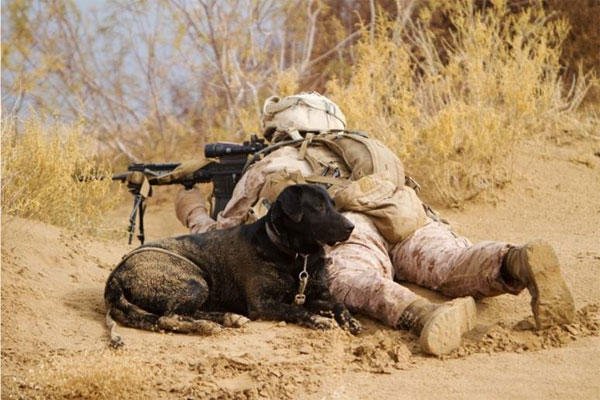Salvation came to the heart of Texas in the form of a four-year-old black Labrador Retriever named Toro.
All through December, schools in Coryell County, Texas received bomb threats. There were 11 threats made that month against Copperas Cove High School, Copperas Cove Junior High and S.C. Lee Junior High.
School officials called to nearby Fort Hood to borrow the Army base’s bomb sniffing dogs, when they were available.
“When those dogs weren’t available, they had to call a private firm at a huge cost,” said Deputy Doyle Dickens of neighboring Bell County.
While these threats were coming in, Deputy Dickens was in Southern Pines, N.C., to pick Toro up. Like those dogs at Fort Hood, Toro had been trained to detect explosive scents. He got that training through the United States Marine Corps as an improvised explosive device detector dog.
Toro is one of hundreds of IED detector dogs that have been transferred to dozens of government agencies, state agencies, universities and local police departments from the Marine Corps.
“He has been a godsend to us,” Deputy Dickens said. “He has been aiding the county in ways that we couldn’t have imagined when we picked him up.”
Deputy Dickens said that Toro has been helpful in proving the presence of explosives, or lack thereof, in ongoing cases. Also, when the time comes, Toro will provide a pre-transportation security sweep for Nidal Hasan, the suspect in the Fort Hood shooting that left 13 dead and 29 wounded.
More than anything Toro provides the comfort of knowing that, should there ever be another bomb threat in Copperas Cove or anywhere nearby, he will be there to help.
According to Deputy Dickens, that would not be the case had Toro not come free of cost to Bell County.
“No way could the county afford to go down and purchase this dog,” he said.
Tight budgets are common among the agencies that adopted IED detector dogs after their retirement from military service.
At $35,000 per dog, Louisiana State Fire Marshal Butch Browning got six figures’ worth of bomb detection for Louisiana in the three IED detector dogs he requested transfer for.
“We probably couldn’t have afforded to buy these dogs,” he said. “In times of shrinking budgets, to get these retired dogs with no cost to the state of Louisiana, that’s tremendous.”
The dogs, having recently completed their training for civilian duty, will be stationed in Baton Rouge, Monroe and Lafayette. With the dogs located strategically in these cities, most of the state of Louisiana will be within an hour and a half of one of the bomb detector dogs.
“It provides a level of security that we want to be able to give to the people here in Louisiana,” Browning said. “And the dogs are top quality.”
That quality allows the dogs to be put to work in diverse fields. What handlers ask Toro to do in Bell County differs from what handlers ask Hope, another black Labrador Retriever, to do at Stanford University.
“Stanford attracts a lot of dignitaries and other significant military officials and other public officials so we have to make sure we have a clear area,” said Stanford University Police Department Lieutenant Kay Iida. “For our campus, these visits happen on a regular basis so we have to make sure we have a dog that can handle that.”
The training process is what sets the IED dogs apart in terms of quality. Labrador Retrievers, at least one year old, start their training in how to detect the scent of explosives and alert their handler at a distance of up to 300 yards. The training lasts at least 70 days.
At the height of Operation Enduring Freedom, this training had produced over 638 dogs that were deployed with Marine units. The requirement sharply dropped in the last year. Sam Pitts, the program manager for the IED dogs program at Marine Corps Systems Command, wanted to see the dogs well taken care of and able to continue their useful service outside of the Marine Corps.
“All of us in the program are taxpayers too,” Pitts said. “We thought that transferring these dogs to federal, state, local and municipal organizations that needed them would not only enhance homeland security but also make good use of the money used to purchase these dogs.”
The transfer program has put dogs into the hands of the Los Angeles Police Department, D.C. Metro Police, the University of Kentucky Police Department and several other agencies across the nation.
If the dogs are not transferred to any of these organizations, they become eligible for adoption. Due to widespread interest, there is a hierarchy for who receives priority for adoption: handlers who are Wounded Warriors, then Wounded Warriors, then handlers, then Marines and finally, the general public.
In all, 378 dogs have been transferred or adopted.
As there is currently a waiting list for transfers and adoptions, any dogs that retire from their service in the Marine Corps will have a good home waiting for them.
“Every single one of these dogs is being transferred or adopted,” Pitts said. “They’re being used or being adopted by a family [who will provide human affection and comfort]. That’s very pleasing to us. They deserve that comfort.”



























